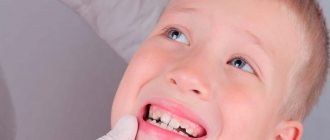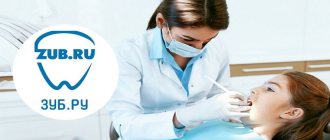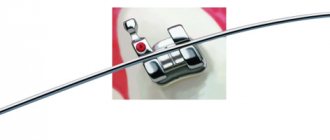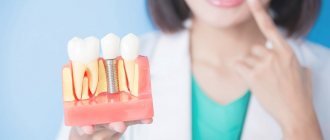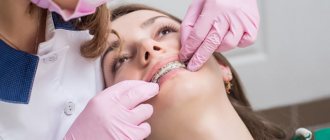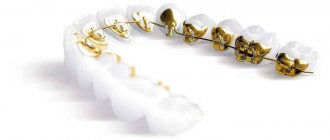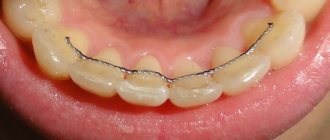To eliminate malocclusion, special braces are installed that remain on the teeth for quite a long time, on average 8-24 months. Many patients are interested in the question: “Do braces damage tooth enamel?” Very often, after braces are removed, various defects can be seen on the enamel; it is no longer as ideal as it used to be before treatment. Orthodontics can cause significant damage to hard and soft tissue. The most important aspect of orthodontic care is maintaining an extremely high level of oral hygiene before and during orthodontic treatment.
So, let's look at braces. Let's start in order
“Brackets thin out the enamel” - no!
It is nonsense. A brace, in essence, is a kind of “sticker or slap” on a tooth. And nothing more. Yes, to fix the bracket on light-curing composites, the doctor needs to apply an etching gel, which is 37% phosphoric acid, to a localized area of enamel. Sound scary? Did you know that exactly the same acid in the same percentage is found in many carbonated drinks? Only we are not afraid to drink them, although the harm here is obviously much greater, because we apply the same etching not to 1 tooth, or rather a small area of it, but to all the teeth in the oral cavity and, moreover, swallow it, irrigating it with this is the entire mucous membrane of the mouth, esophagus and stomach. we exclude the fact of total thinning of the enamel from tooth etching
.
The brace itself cannot change the thickness of the enamel layer, because enamel is the hardest tissue in the human body and the brace does not emit any acids that can affect the enamel, unless there are dissimilar metal crowns in the mouth, due to which the notorious galvanic cell (school chemistry course), which can lead to a change in the acid balance in the oral cavity. But this is a separate topic.
Next: about braces, plaque and caries.
Again, braces themselves do not cause tooth decay. Caries develops when there is plaque on the tooth, from which, in fact, acids are released that destroy the enamel. But! Braces really contribute to the accumulation of plaque, no matter what material they are made of. This is precisely why we, dentists of all specialties, repeat tirelessly: you need to brush your teeth! And orthodontists say that you need to brush your teeth even more often and more diligently, because plaque forms faster and more intensely, which means the risk of developing caries is much higher. So this situation is literally in the hands of the patient himself. We can only monitor it, give recommendations and promptly send it to a dental hygienist for professional oral hygiene.
About gums and braces.
Yes, the trigger for almost all gum diseases is the same plaque. Thus, all troubles begin with poor oral hygiene
. Remember this.
Consequences of braces after removal
The “adventures” of patients who want to get a perfect smile do not end even after the braces are removed. Possible problems include:
- The appearance of unsightly stains on the enamel. This defect is a consequence of poor dental hygiene and enamel pigmentation characteristics. It can be removed using bleaching and remineralizing procedures.
- The face acquires a more elongated shape. The cheeks may sink and the nasolabial folds may deepen. Fortunately, this violation is quite rare. Special gymnastics for the facial muscles helps return the face to its original shape. But it needs to be done for a long time and on an ongoing basis.
- Weakening of enamel. Being under the locks, the enamel tissues do not receive the substances they need. This negatively affects their condition. You can minimize the risk of complications by using strengthening agents prescribed by your dentist.
- Restoring the teeth to their previous position. This is possible if, after removing braces, the patient refused to wear retainers. Then, freed from pressure, some units try to take their former place. Under no circumstances should this be allowed. If the doctor told you to wear plates, then that’s what you need to do. Otherwise, all efforts will go to waste.
Is it possible to wear braces during pregnancy?
Modern braces are absolutely harmless to the body and do not cause allergies. Therefore, wearing them in itself does not in any way affect the course of pregnancy and the intrauterine development of the child. But this is subject to careful oral care! ⠀ Of course, hormonal imbalance affects the condition of the bone, but here it is necessary to conduct research from specialists and only after that decide whether treatment or continuation of treatment during pregnancy is possible. It is better to plan the installation of braces 1-2 months before pregnancy, so that all the necessary studies do not negatively affect the fetus (X-rays, CT scans, etc.). ⠀ According to experienced orthodontists, if a woman becomes pregnant, then there is no need to do anything special. It makes sense to wear braces until you finish breastfeeding, even if it is possible and will be for quite a long time. However, this will allow the bone tissue to normalize, and the woman will not miss out on the results of treatment already obtained before pregnancy. If you are pregnant or plan to become pregnant, be sure to talk to your doctor. Only a specialist will be able to correctly assess your condition and prescribe the necessary course of action!
Is it possible to treat teeth during pregnancy?
What happens to the face while wearing braces?
The extent to which braces can change the shape of the face depends on the degree of tooth deformation and the type of bite that needs to be corrected. The behavior of the patient himself is also important - how accurately he will comply with the orthodontist’s instructions.
When wearing braces, interrelated changes occur in the maxillofacial structures. As they say in this case, braces break the face. The gradual displacement of bone tissue affects the muscles - their tone increases or, conversely, decreases. Let's take a closer look at how individual facial structures change.
How to avoid?
Prevention of unpleasant consequences consists of certain actions:
- Maintain careful oral hygiene. The need for cleansing after each meal has already been mentioned above. During daily procedures, it is recommended to use dental floss, orthodontic brushes, and irrigators.
- Cleaning technique . During hygiene, you should not put excessive pressure on the enamel and gums.
- Elimination of self-removal of the structure. Even if there is a very compelling reason and a serious complication occurs, only a specialist should remove braces.
- Timely contact with the orthodontist . If you suddenly encounter a breakdown or damage to the structure, immediately seek help from a specialist.
It is important to follow all the doctor’s recommendations. This can include not only hygiene, but also nutritional rules, preventive visits to the dentist, and timely elimination of emerging problems.
The video provides information about the benefits and harms of braces.
Is it possible to treat teeth if braces are installed?
Orthodontic braces complicate the procedure of cleaning teeth, which can be one of the reasons for the development of caries after braces are installed. However, their presence in the oral cavity is not a contraindication for the treatment of carious lesions. Moreover, it is absolutely impossible to leave a sick tooth without attention.
Braces are worn for quite a long time - from several months to 2-3 years, depending on the complexity of the disease. During this time, pathology can completely destroy the dental unit. In addition, there is a risk that it will spread to neighboring teeth or cause other infectious and inflammatory diseases of the oral cavity, for example, periodontitis, gingivitis, etc.
Due to such complications, orthodontic treatment will need to be suspended. The doctor will remove the braces and begin to eliminate any pathologies that have developed. As a result, therapy will be delayed. In addition, additional procedures, including reinstallation of the structure, will have to be paid separately.
To prevent this, carious lesions are treated immediately after they are identified. If necessary, the dentist will carefully remove the archwire, prepare the tooth and place a filling. It is extremely rare to open and peel off locks to cure caries. Usually this has to be done in situations where a pathological process develops directly around the lock. Sometimes braces, on the contrary, simplify the procedure for treating a carious tooth. Let us tell you what cases we are talking about.
Prices for installing braces
| Name | Price |
| Ceramic braces | 40,000 rub. |
| Metal braces | 25,000 rub. |
| Lingual brace system “Incognito” | 300,000 rub. |
| Observation (one visit) | 500 rub. |
| Treatment of dental anomalies (Invisioline) | from 20,000 rub. |
| Treatment of dental anomalies of the 1st degree of complexity | 25,000 rub. |
| Treatment of dental anomalies of the 2nd degree of complexity | 50,000 rub. |
| Treatment of dental anomalies of the 3rd degree of complexity | 75,000 rub. |
| Treatment of dental anomalies of the 4th degree of complexity | 100,000 rub. |
What is a good orthodontist?
Personally, I am always in favor of the patient receiving at least two third-party opinions. Orthodontic treatment must be approached very seriously, because you are committed to a relationship with the doctor for 1-2 years (or even more). Without mutual understanding, orthodontic treatment is doomed! There are several most important criteria when choosing a doctor:
- High-quality collection of information/diagnostic data
The doctor must make impressions, then carry out calculations on the models, study the OPTG image or CBCT (3-D image), and take intraoral photographs. ONLY after this can you begin treatment with the bracket system. Taking photographs is also a very important diagnostic step.
- Reviews and reputation
I won’t say obvious things here, but it’s worth paying more attention to the doctor’s actual work, rather than reviews on his personal page. By the way, negative reviews are often really unsolicited, but they can be found for literally every doctor (even the best of the best), so filter the information received. Well, no one canceled the recommendations of friends.
- Availability of diplomas/certificates
Having certificates is far from an empty phrase. This suggests that the doctor wants to develop in his field and know about new developments in the field of medicine. Do not hesitate to ask questions about where the doctor received his knowledge, practice, etc.
- Employment
Sometimes we have to work quickly, on the fly. But alas, the case is not always immediately clear. And in general, orthodontics is a science where you need to think a lot. After all, bite alignment is a kind of arcade game for the doctor. Just clarify what the doctor's plans are for you and make sure that the doctor treats your case carefully.
Orthodontists KANO
What to do before installation?
Before starting treatment, it is necessary to undergo special diagnostic procedures (taking impressions, making jaw models, x-ray examination of the dentition and skull bones). They are necessary for making a final diagnosis and correct treatment planning.
Before fixing braces, it is important to carry out professional hygiene and treatment of all teeth. There should be no carious cavities. Next comes the stage of fixing braces and orthodontic treatment.
Constant problems of “temporaries”. Do baby teeth need to be treated? More details
I'm already old/too old for braces
In fact, today the framework in orthodontic treatment has been completely erased. Of course, each age has its own subtleties of work for a doctor. However, the result is always the same. And one more fact - people sometimes lose their teeth not because of caries and other dental problems, but because of an incorrect bite. When the load is distributed unevenly, it ultimately leads to bone loss and tooth wear.
I will not tire of repeating that we do straight teeth not only to solve aesthetic problems. Often this will save you from early tooth loss.
Is it possible to do without retention and what is it even?
Retention is perhaps one of the most important parts of the entire treatment. Why? Teeth are harmful guys, and they will try to return to their original position, which is comfortable only for them. This is called a relapse. But neither I nor my patient want this. That’s why I really insist on retention, often even suggesting double retention.
What is retention? This is a removable or non-removable device designed to hold the dentition in the desired position. This could be a splint, a retainer (an arch behind the teeth), a night guard, or a plate.
Retainer after braces
